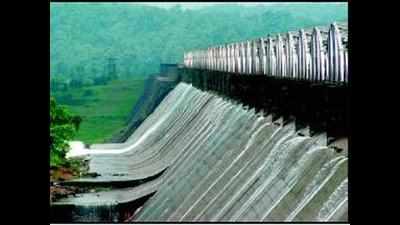- News
- City News
- nashik News
- NGO refutes WRD claims on water flow to Jayakwadi
Trending
This story is from July 12, 2016
NGO refutes WRD claims on water flow to Jayakwadi
A city-based non-governmental organisation (NGO) has contradicted the claims made by the water resources department about the amount of water that has naturally passed from Nashik to Jayakwadi dam since Sunday morning.

According to the government agency, about 1,000 million cubic feet (mcft) water has flowed into Jayakwadi dam. (Representative image)
Nashik: A city-based non-governmental organisation (NGO) has contradicted the claims made by the water resources department about the amount of water that has naturally passed from Nashik to Jayakwadi dam since Sunday morning.
According to the government agency, about 1,000 million cubic feet (mcft) water has flowed into Jayakwadi dam. However, as per Rajendra Jadhav of Jalchintan, an NGO that studies water resources, more than 4,000 mcft water from the city has gone towards Jayakwadi after Nashik witnessed the heaviest rainfall in recent times on Sunday.
The figures gain significance when it comes to the issue of equitable water sharing between Nashik and Marathwada.
"Just imagine, the water resources department is claiming that the flow of water through Panchavati was 18,000 cusecs of water flowing down and another 10,000 cusecs of water gushing into the river from the free catchment areas below Nashik city and the water released from Darna river as well. All put together, there is a certain 40,000 cubic feet per second (cusec) of discharge at Nandurmadhmeshwar, which is supposed to be the border of Nashik district, after which the water flows into Jayakwadi dam in Aurangabad district. The result is 4,000 mcft of water flowing down," Jadhav said.
No discharge of water was noted from either Nilwande (Bhandardara) dam or from the Mula dam.
The amount of water flowing down to Jayakwadi from Nashik has to be maintained and checked from the first day of the monsoon. The water used for drinking purpose is released through canals for parched regions (Yeola, Manmad in Nashik district; Kopargaon, Rahata, Shirdi in Ahmednagar district) and every drop is accountable.
Jadhav said that earlier, too, because of the "wrong figures" given by the department about water in dams, Nashik had released 1.34 thousand million cubic feet (TMC) of water for Jayakwadi on the orders of the Godavari Marathwada Irrigation Development Corporation. As a result, the citizens of Nashik suffered to the extent that their farms did not get water, he said.
"It may also be noted that the amount of water released never reached the destination in full. Then it is important that the WRD should maintain thorough records," Jadhav added.
The WRD officer, however, maintained that the records were being updated and henceforth, figures gauged every two hours would be noted for clarity. "We have asked the officials to maintain records of the gauges every two hours and this will start from now on," the official said.
According to the government agency, about 1,000 million cubic feet (mcft) water has flowed into Jayakwadi dam. However, as per Rajendra Jadhav of Jalchintan, an NGO that studies water resources, more than 4,000 mcft water from the city has gone towards Jayakwadi after Nashik witnessed the heaviest rainfall in recent times on Sunday.
The figures gain significance when it comes to the issue of equitable water sharing between Nashik and Marathwada.
"Just imagine, the water resources department is claiming that the flow of water through Panchavati was 18,000 cusecs of water flowing down and another 10,000 cusecs of water gushing into the river from the free catchment areas below Nashik city and the water released from Darna river as well. All put together, there is a certain 40,000 cubic feet per second (cusec) of discharge at Nandurmadhmeshwar, which is supposed to be the border of Nashik district, after which the water flows into Jayakwadi dam in Aurangabad district. The result is 4,000 mcft of water flowing down," Jadhav said.
The water resources department, however, put the water discharge at Nandurmadhmeshwar at 23,326 cusecs. "On an average, it can be noted that about 1,000 mcft of water has crossed the gated pick-up weir in Jayakwadi dam. It is another thing as to how much of water will reach the dam following the river bed conditions before the dam," a senior official from the department said.
No discharge of water was noted from either Nilwande (Bhandardara) dam or from the Mula dam.
The amount of water flowing down to Jayakwadi from Nashik has to be maintained and checked from the first day of the monsoon. The water used for drinking purpose is released through canals for parched regions (Yeola, Manmad in Nashik district; Kopargaon, Rahata, Shirdi in Ahmednagar district) and every drop is accountable.
Jadhav said that earlier, too, because of the "wrong figures" given by the department about water in dams, Nashik had released 1.34 thousand million cubic feet (TMC) of water for Jayakwadi on the orders of the Godavari Marathwada Irrigation Development Corporation. As a result, the citizens of Nashik suffered to the extent that their farms did not get water, he said.
"It may also be noted that the amount of water released never reached the destination in full. Then it is important that the WRD should maintain thorough records," Jadhav added.
The WRD officer, however, maintained that the records were being updated and henceforth, figures gauged every two hours would be noted for clarity. "We have asked the officials to maintain records of the gauges every two hours and this will start from now on," the official said.
End of Article
FOLLOW US ON SOCIAL MEDIA










